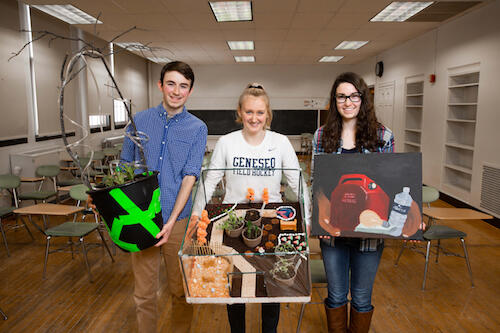
Ethan Smith '20, Ariana Walczyk '19, and Sara Feinland '19 show their art projects that speak to sustainability and political issues. (SUNY Geneseo/Keith Walters '11)
Students in a spring honors course, The Politics of Sustainability Through Art, are exploring in a creative way environmental concerns and the politics that affect sustainability issues.
In addition to examining background readings on climate change, food sustainability, and other problems, students view and discuss relevant artwork by artists from around the world and create their own visual art inspired by their learning.
The course was developed and is taught by Karleen West, associate professor of political science and international relations, and Dan DeZarn, a sculptor and Geneseo’s director of the Office of Sustainability.
The class explores how political systems affect social and ecological systems, how art can articulate the relationship between poverty, social justice, and ecological destruction, and how art can foster connections between diverse communities.
The course provides an opportunity for students to examine issues in a local, regional, and global context and connect with them in a deeper way, said DeZarn. As they develop ideas, they also solve how they will create art to share their message clearly with classmates.
“It can be really impactful in the way they think about or approach a problem,” said West.
Students in the course come from diverse academic backgrounds, which facilitates discussions and many perspectives. Sara Feinland ’19 is a biochemistry major. Ethan Smith ’20, an Edgar Fellows Program student, is a physics major. Ariana Walczyk ’19 is a biology major.
“This class has made me think more critically about my part in the systems that I benefit from,” said Feinland, “and what I can do to make these systems more sustainable.”
The students recently completed and presented their first art projects.
Walczyk created a diorama of a garden filled with natural features and very processed foods. Chicken nuggets represented chickens in a yard, and she made a bench out of processed cheese to show what processed items we still call food. Smith used the physical reaction of Mentos candies and soda to water a fake plant in a planter that he had broken and taped together. It demonstrated the limitations individuals have trying to address environmental issues in a broken system, he said.
Feinland chose to look more closely at modern food systems, which allow her to easily grab a meal in a campus restaurant or grocery shop. Inspired by 17th-century still life paintings of luxury foods often depicted on a table, Feinland painted resources needed for a meal today. A gas can represented the transportation of goods, a light bulb the electricity used, a plastic bottle the water consumed, money a for-profit system, and hands a farmer or worker who may not be fairly compensated for his or her effort.
“I wanted to make this work highlight the aspects of food consumption that we do not normally think about,” she said.
Check out Geneseo's sustainability map which shows how alumni and the College community address the U.N. Sustainability Goals.